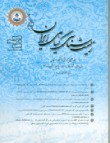The effect of iron deficiency on the expression of genes encoding carbonic anhydrase, peroxidase and glutathione S-transferase enzymes in bread wheat
Author(s):
Article Type:
Research/Original Article (دارای رتبه معتبر)
Abstract:
Wheat is the main source of carbohydrates and food source for human consumption. During growth period, it faces with various environmental stresses, including low micronutrients stress such as iron. One of the plant strategies to deal with environmental stresses, is the use of enzymatic antioxidant defense system. To investigate the effect of iron deficiency stress on the expression of genes carbonic anhydrase (CAR), peroxidase (PRX) and glutathione S-transferase (GTS) in Fe-efficient (Pishtaz) and -inefficient (Falat) bread wheat cultivars, a factorial greenhouse experiment was implemented in a completely randomized design with three replications. Cultivars were planted at two levels of iron: 1.4 (iron deficiency) and 10 milligrams of Fe per kilogram of soil (sufficient iron), and leaves and roots of the plants were sampled at two stages, one month after germination (vegetation) and 30% of heading (reproduction). The relative expression level of the mentioned genes was measured in the leaves and roots of the cultivars using Real time PCR technique. Results revealed the highest increase in carbonic anhydrase expression in iron deficiency conditions in the roots of Fe-inefficient cultivar (Falat) at vegetative stage, while the highest increase in the expression of peroxidase and glutathione S-transferase genes were observed in the leaves and roots of the Fe-efficient cultivar at the vegetative and reproductive stages, respectively, under iron deficiency conditions. Therefore, the increased expression of the genes encoding peroxidase and glutathione S-transferase enzymes in Fe-efficient cultivar shows that these cultivars use antioxidant enzymes more effectively to deal with soil iron deficiency stress. IntroductionWheat is the main source of carbohydrates and the most important source of food for human consumption. The plant faces various environmental stresses, including micronutrient deficiency stress, such as iron. One of the plant strategies to deal with environmental stresses is the use of an enzymatic antioxidant defense system. Peroxidase and glutathione S-transferase are antioxidant enzymes that plants use to deal with environmental stress. Peroxidase enzymes are a large group of iron-containing proteins that participate in electron transfer from biological membranes and oxidative reactions (Vlasits et al., 2010). These enzymes play a role in removing all kinds of oxidizing agents and free radicals produced under stress conditions. Plant peroxidases are the only class ІІІ peroxidase enzymes that work in the extracellular space to inhibit H2O2-induced damage (Glusac et al., 2019). Glutathione S-transferases are multifunctional enzymes with multiple substrates, which enable them to catalyze a wide range of reactions. These enzymes are used as hormones carrier, secondary metabolites, and other enzymes. In addition, these enzymes play a significant role in tolerance to biotic / abiotic stresses and regulation of intracellular homeostasis (Hernandez et al., 2020). Materials and MethodsTo investigate the effect of iron deficiency stress on the expression of genes encoding carbonic anhydrase, peroxidase, and glutathione S-transferase enzymes in iron-efficient (Pishtaz) and -inefficient (Falat) bread wheat cultivars, a factorial greenhouse experiment was carried out in a completely randomized design (CRD) with three replications. Cultivars were planted at two levels of iron: 1.4 (iron deficiency) and 10 (iron sufficiency) mg/kg soil, and leaves and roots of the plants were harvested in two stages, one month after germination (vegetation) and 30% of heading (reproduction). The relative expression level of the mentioned genes was measured in the leaves and roots of the cultivars using the Real-time PCR technique under iron deficiency conditions compared to the control conditions. The actin gene was used as a reference gene to normalize the data. After the Real-time PCR reactions, the melting curve analysis was implemented for each gene to ensure the specificity of the amplified products. Also, the specificity of the products was confirmed using agarose gel analysis. Then, the threshold cycle was extracted from the amplification curves using Rotor-Gene Q software, and the relative expression level of the genes was calculated using the ΔΔCT method (Pfaffi, 2001). The normality of the residuals and gene expression data was tested using the Kolmograph-Smirnov method implemented in MINITAB 19 software, and then data were subjected to analysis of variance. The comparison of the means was performed using the SNK test in SAS 2.9. Results and DiscussionThe results revealed the highest increase in carbonic anhydrase expression in the roots of the Fe-inefficient cultivar in the vegetative stage under iron deficiency conditions. Also, the expression level of this gene in the roots of this cultivar in the vegetative stage was significantly higher than that of Fe-efficient cultivar. No significant difference was observed between the expression levels of this gene in the leaves of two cultivars in the vegetative stage and in the roots and leaves of both cultivars in the reproductive stage. The highest increase in the expression of peroxidase and glutathione S-transferase genes under iron deficiency conditions was found in the leaves and roots of the Fe-efficient cultivar, respectively, in the vegetative and reproductive stages. Also, the level of expression of the glutathione S-transferase gene in the leaves of the Fe-efficient cultivar in the vegetative stage and the roots of the same cultivar in the reproductive stage had a significant difference compared to the leaves and roots of the Fe-inefficient cultivar. Oxidative stress caused by increasing in the level ofreactive oxygen species in iron deficiency conditions can lead to damage to cellular components such as proteins, DNA, and membrane lipids. Plants have developed antioxidant systems to deal with oxidative stress and regulate the levels of reactive oxygen species under stress conditions, which includes some antioxidant enzymes such as peroxidase and glutathione S-transferase. (Hernandez and Rodriguez, 2020). ConclusionThe results of the current investigation revealed the highest increase in the expression of the carbonic anhydrase gene under iron deficiency conditions in the roots of the Fe-inefficient cultivar (Falat) in vegetative stage, while the highest increase in the expression of peroxidase and glutathione S-transferase genes under iron deficiency conditions was observed in the leaves and roots of the Fe-efficient cultivar in the vegetative and reproductive stages, respectively. Therefore, the increased expression of genes encoding peroxidase and glutathione S-transferase enzymes in Fe-efficient bread wheat cultivars demonstrates that these cultivars use antioxidant enzymes more effectively to deal with soil iron deficiency stress.
Keywords:
Language:
Persian
Published:
Iranian Journal of Plant Biology, Volume:14 Issue: 3, 2023
Pages:
1 to 12
magiran.com/p2635866
دانلود و مطالعه متن این مقاله با یکی از روشهای زیر امکان پذیر است:
اشتراک شخصی
با عضویت و پرداخت آنلاین حق اشتراک یکساله به مبلغ 1,390,000ريال میتوانید 70 عنوان مطلب دانلود کنید!
اشتراک سازمانی
به کتابخانه دانشگاه یا محل کار خود پیشنهاد کنید تا اشتراک سازمانی این پایگاه را برای دسترسی نامحدود همه کاربران به متن مطالب تهیه نمایند!
توجه!
- حق عضویت دریافتی صرف حمایت از نشریات عضو و نگهداری، تکمیل و توسعه مگیران میشود.
- پرداخت حق اشتراک و دانلود مقالات اجازه بازنشر آن در سایر رسانههای چاپی و دیجیتال را به کاربر نمیدهد.
In order to view content subscription is required
Personal subscription
Subscribe magiran.com for 70 € euros via PayPal and download 70 articles during a year.
Organization subscription
Please contact us to subscribe your university or library for unlimited access!



